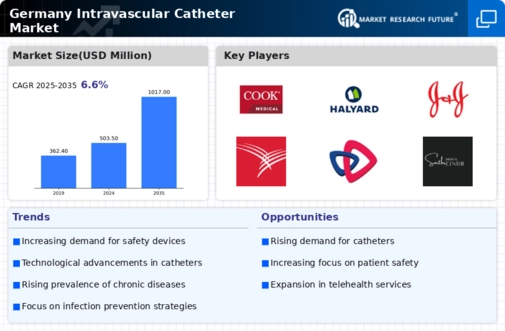Expansion of Home Healthcare Services
The expansion of home healthcare services in Germany is emerging as a key driver for the intravascular catheter market. As more patients receive care at home, the need for portable and user-friendly intravascular catheters is increasing. This trend is particularly relevant for patients with chronic conditions requiring long-term intravenous therapy. The home healthcare market is projected to grow by 8% annually, creating opportunities for manufacturers to develop specialized catheters suited for home use. Consequently, the intravascular catheter market is likely to experience growth as healthcare providers adapt to this shift in patient care settings.
Growing Awareness of Infection Control
The heightened focus on infection control in healthcare settings is influencing the intravascular catheter market in Germany. Healthcare professionals are increasingly aware of the risks associated with catheter-related infections, leading to the adoption of advanced catheter technologies designed to minimize these risks. The market is witnessing a shift towards catheters with antimicrobial coatings and other safety features. In 2025, it is estimated that infection control measures will account for approximately 30% of the total expenditure on intravascular devices. This growing awareness is likely to drive demand for innovative products that enhance patient safety and reduce infection rates.
Technological Innovations in Catheter Design
Technological innovations in catheter design are significantly impacting the intravascular catheter market in Germany. Manufacturers are investing in research and development to create catheters that offer enhanced functionality, such as improved flexibility, biocompatibility, and ease of insertion. These advancements are expected to lead to better patient outcomes and increased satisfaction among healthcare providers. In 2025, the market for advanced catheter technologies is projected to grow by 7%, driven by the introduction of smart catheters equipped with sensors for real-time monitoring. This focus on innovation is likely to position the intravascular catheter market for sustained growth in the coming years.
Rising Demand for Minimally Invasive Procedures
The increasing preference for minimally invasive procedures in Germany is driving the intravascular catheter market. These procedures are associated with reduced recovery times, lower risk of complications, and shorter hospital stays. As healthcare providers aim to enhance patient outcomes, the demand for intravascular catheters is likely to rise. In 2025, the market is projected to grow at a CAGR of approximately 6.5%, reflecting the shift towards less invasive techniques. This trend is further supported by advancements in catheter design and materials, which improve performance and safety. Consequently, the intravascular catheter market is expected to benefit from this growing inclination towards minimally invasive surgical options.
Increased Investment in Healthcare Infrastructure
Germany's commitment to enhancing its healthcare infrastructure is a significant driver for the intravascular catheter market. The government has allocated substantial funds to modernize hospitals and healthcare facilities, which includes upgrading medical equipment. This investment is anticipated to boost the availability and use of advanced intravascular catheters. In 2025, healthcare spending in Germany is expected to reach €500 billion, with a notable portion directed towards innovative medical technologies. As hospitals adopt state-of-the-art equipment, the demand for high-quality intravascular catheters is likely to increase, thereby propelling market growth.


















Leave a Comment